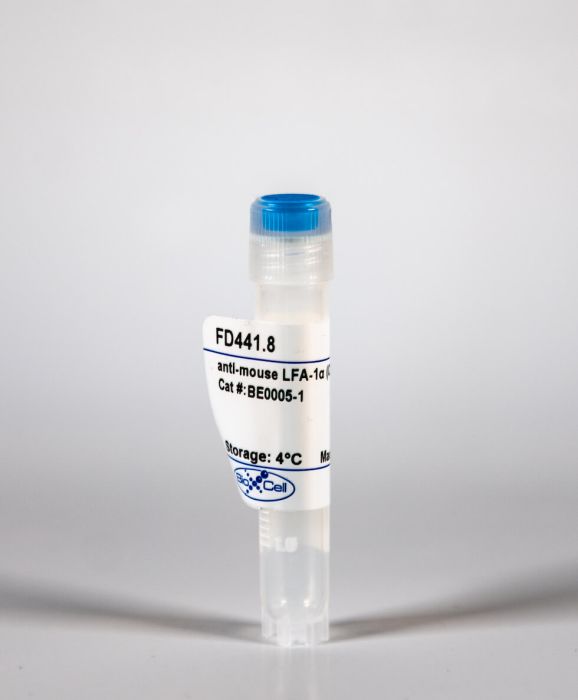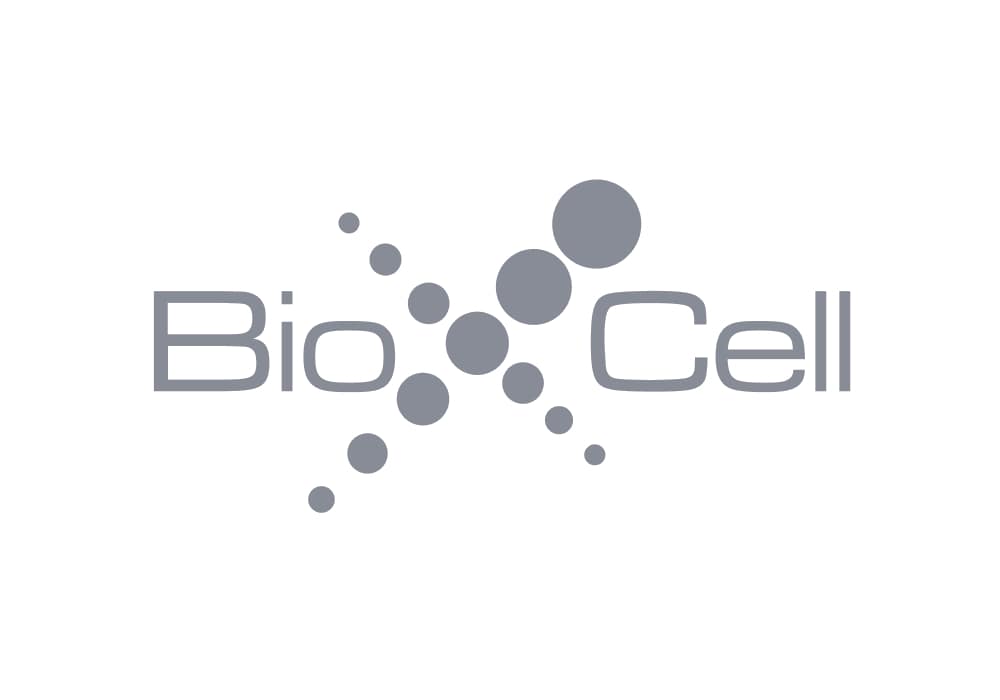InVivoMAb anti-mouse LFA-1α (CD11a)
Product Details
The FD441.8 monoclonal antibody reacts with mouse LFA-1α (lymphocyte function-associated antigen 1 alpha) also known as integrin alpha L chain and CD11a. LFA-1α and CD18 combine to form LFA-1, a 180 kDa glycoprotein and a member of the integrin family. LFA-1 is expressed on the surface of all leukocytes including lymphocytes, monocytes, macrophages, and granulocytes. LFA-1 plays a central role in leukocyte intercellular adhesion through interactions with its ligands, ICAM-1 (CD54), ICAM-2 (CD102), and ICAM-3 (CD50), and also functions in lymphocyte costimulatory signaling.Specifications
| Isotype | Rat IgG2b |
|---|---|
| Recommended Isotype Control(s) | InVivoMAb rat IgG2b isotype control, anti-keyhole limpet hemocyanin |
| Recommended Dilution Buffer | InVivoPure pH 7.0 Dilution Buffer |
| Immunogen | Cloned CTL B18 cells |
| Reported Applications | in vivo LFA-1 neutralization |
| Formulation |
PBS, pH 7.0 Contains no stabilizers or preservatives |
| Endotoxin |
<2EU/mg (<0.002EU/μg) Determined by LAL gel clotting assay |
| Sterility | 0.2 μM filtered |
| Production | Purified from tissue culture supernatant in an animal free facility |
| Purification | Protein G |
| RRID | AB_1107574 |
| Molecular Weight | 150 kDa |
| Storage | The antibody solution should be stored at the stock concentration at 4°C. Do not freeze. |
Recommended Products
in vivo LFA-1 neutralization
Antibody-mediated B-cell depletion before adoptive immunotherapy with T cells expressing CD20-specific chimeric T-cell receptors facilitates eradication of leukemia in immunocompetent mice PubMed
We have established a model of leukemia immunotherapy using T cells expressing chimeric T-cell receptors (cTCRs) targeting the CD20 molecule expressed on normal and neoplastic B cells. After transfer into human CD20 (hCD20) transgenic mice, cTCR(+) T cells showed antigen-specific delayed egress from the lungs, concomitant with T-cell deletion. Few cTCR(+) T cells reached the bone marrow (BM) in hCD20 transgenic mice, precluding effectiveness against leukemia. Anti-hCD20 antibody-mediated B-cell depletion before adoptive T-cell therapy permitted egress of mouse CD20-specific cTCR(+) T cells from the lungs, enhanced T-cell survival, and promoted cTCR(+) T cell-dependent elimination of established mouse CD20(+) leukemia. Furthermore, CD20-specific cTCR(+) T cells eliminated residual B cells refractory to depletion with monoclonal antibodies. These findings suggest that combination of antibody therapy that depletes antigen-expressing normal tissues with adoptive T-cell immunotherapy enhances the ability of cTCR(+) T cells to survive and control tumors.
in vivo LFA-1 neutralization
LFA-1 antagonism inhibits early infiltration of endogenous memory CD8 T cells into cardiac allografts and donor-reactive T cell priming PubMed
Alloreactive memory T cells are present in virtually all transplant recipients due to prior sensitization or heterologous immunity and mediate injury undermining graft outcome. In mouse models, endogenous memory CD8 T cells infiltrate MHC-mismatched cardiac allografts and produce IFN-gamma in response to donor class I MHC within 24 h posttransplant. The current studies analyzed the efficacy of anti-LFA-1 mAb to inhibit early CD8 T cell cardiac allograft infiltration and activation. Anti-LFA-1 mAb given to C57BL/6 6 (H-2(b)) recipients of A/J (H-2(a)) heart grafts on days -1 and 0 completely inhibited CD8 T cell allograft infiltration, markedly decreased neutrophil infiltration and significantly reduced intragraft expression levels of IFN-gamma-induced genes. Donor-specific T cells producing IFN-gamma were at low/undetectable numbers in spleens of anti-LFA-1 mAb treated recipients until day 21. These effects combined to promote substantial prolongation (from day 8 to 27) in allograft survival. Delaying anti-LFA-1 mAb treatment until days 3 and 4 posttransplant did not inhibit early memory CD8 T cell infiltration and proliferation within the allograft. These data indicate that peritransplant anti-LFA-1 mAb inhibits early donor-reactive memory CD8 T cell allograft infiltration and inflammation suggesting an effective strategy to attenuate the negative effects of heterologous immunity in transplant recipients.
in vivo CD4+ T cell depletion, In vivo ICAM-1 neutralization, in vivo LFA-1 neutralization
Hapten application to the skin induces an inflammatory program directing hapten-primed effector CD8 T cell interaction with hapten-presenting endothelial cells PubMed
Contact hypersensitivity is a CD8 T cell-mediated response to hapten sensitization and challenge of the skin. Effector CD8 T cell recruitment into the skin parenchyma to elicit the response to hapten challenge requires prior CXCL1/KC-directed neutrophil infiltration within 3-6 h after challenge and is dependent on IFN-gamma and IL-17 produced by the hapten-primed CD8 T cells. Mechanisms directing hapten-primed CD8 T cell localization and activation in the Ag challenge site to induce this early CXCL1 production in response to 2,4-dinitrofluorobenzene were investigated. Both TNF-alpha and IL-17, but not IFN-gamma, mRNA was detectable within 1 h of hapten challenge of sensitized mice and increased thereafter. Expression of ICAM-1 was observed by 1 h after challenge of sensitized and nonsensitized mice and was dependent on TNF-alpha. The induction of IL-17, IFN-gamma, and CXCL1 in the challenge site was not observed when ICAM-1 was absent or neutralized by specific Ab. During the elicitation of the contact hypersensitivity response, endothelial cells expressed ICAM-1 and produced CXCL1 suggesting this as the site of CD8 T cell localization and activation. Endothelial cells isolated from challenged skin of naive and sensitized mice had acquired the hapten and the ability to activate hapten-primed CD8 T cell cytokine production. These results indicate that hapten application to the skin of sensitized animals initiates an inflammatory response promoting hapten-primed CD8 T cell localization to the challenge site through TNF-alpha-induced ICAM-1 expression and CD8 T cell activation to produce IFN-gamma and IL-17 through endothelial cell presentation of hapten.
in vivo LFA-1 neutralization
Endogenous memory CD8 T cells are activated within cardiac allografts without mediating rejection PubMed
Endogenous memory CD8 T cells infiltrate MHC-mismatched cardiac allografts within 12-24 h posttransplant in mice and are activated to proliferate and produce IFN-gamma. To more accurately assess the graft injury directly imposed by these endogenous memory CD8 T cells, we took advantage of the ability of anti-LFA-1 mAb given to allograft recipients on days 3 and 4 posttransplant to inhibit the generation of primary effector T cells. When compared to grafts from IgG-treated recipients on day 7 posttransplant, allografts from anti-LFA-1 mAb-treated recipients had increased numbers of CD8 T cells but these grafts had marked decreases in expression levels of mRNA encoding effector mediators associated with graft injury and decreases in donor-reactive CD8 T cells producing IFN-gamma. Despite this decreased activity within the allograft, CD8 T cells in allografts from recipients treated with anti-LFA-1 mAb continued to proliferate up to day 7 posttransplant and did not upregulate expression of the exhaustion marker LAG-3 but did have decreased expression of ICOS. These results indicate that endogenous memory CD8 T cells infiltrate and proliferate in cardiac allografts in mice but do not express sufficient levels of functions to mediate overt graft injury and acute rejection.
in vivo LFA-1 neutralization
Pancreatic islet xenograft survival in mice is extended by a combination of alpha-1-antitrypsin and single-dose anti-CD4/CD8 therapy PubMed
Clinical pancreatic islet transplantation is under evaluation for the treatment of autoimmune diabetes, yet several limitations preclude widespread use. For example, there is a critical shortage of human pancreas donors. Xenotransplantation may solve this problem, yet it evokes a rigorous immune response which can lead to graft rejection. Alpha-1-antitrypsin (AAT), a clinically available and safe circulating anti-inflammatory and tissue protective glycoprotein, facilitates islet alloimmune-tolerance and protects from inflammation in several models. Here, we examine whether human AAT (hAAT), alone or in combination with clinically relevant approaches, achieves long-term islet xenograft survival. Rat-to-mouse islet transplantation was examined in the following groups: untreated (n = 6), hAAT (n = 6, 60-240 mg/kg every 3 days from day -10), low-dose co-stimulation blockade (anti-CD154/LFA-1) and single-dose anti-CD4/CD8 (n = 5-7), either as mono- or combination therapies. Islet grafting was accompanied by blood glucose follow-up. In addition, skin xenografting was performed in order to depict responses that occur in draining lymph nodes. According to our results hAAT monotherapy and hAAT/anti-CD154/LFA-1 combined therapy, did not delay rejection day (11-24 days untreated vs. 10-22 day treated). However, host and donor intragraft inflammatory gene expression was diminished by hAAT therapy in both setups. Single dose T-cell depletion using anti-CD4/CD8 depleting antibodies, which provided 14-15 days of reduced circulating T-cells, significantly delayed rejection day (28-52 days) but did not achieve graft acceptance. In contrast, in combination with hAAT, the group displayed significantly extended rejection days and a high rate of graft acceptance (59, 61, >90, >90, >90). In examination of graft explants, marginal mononuclear-cell infiltration containing regulatory T-cells predominated surviving xenografts. We suggest that temporal T-cell depletion, as in the clinically practiced anti-thymocyte-globulin therapy, combined with hAAT, may promote islet xenograft acceptance. Further studies are required to elucidate the mechanism behind the observed synergy, as well as the applicability of the approach for pig-to-human islet xenotransplantation.
in vivo LFA-1 neutralization
Endogenous memory CD8 T cells directly mediate cardiac allograft rejection PubMed
Differences in levels of environmentally induced memory T cells that cross-react with donor MHC molecules are postulated to account for the efficacy of allograft tolerance-inducing strategies in rodents versus their failure in nonhuman primates and human transplant patients. Strategies to study the impact of donor-reactive memory T cells on allografts in rodents have relied on the pretransplant induction of memory T cells cross-reactive with donor allogeneic MHC molecules through recipient viral infection, priming directly with donor antigen or adoptive transfer of donor antigen primed memory T cells. Each approach accelerates allograft rejection and confers resistance to tolerance induction, but also biases the T cell repertoire to strong donor reactivity. The ability of endogenous memory T cells within unprimed mice to directly reject an allograft is unknown. Here, we show a direct association between increased duration of cold ischemic allograft storage and numbers and enhanced functions of early graft infiltrating endogenous CD8 memory T cells. These T cells directly mediate rejection of allografts subjected to prolonged ischemia and this rejection is resistant to costimulatory blockade. These findings recapitulate the clinically significant impact of endogenous memory T cells with donor reactivity in a mouse transplant model in the absence of prior recipient priming.


